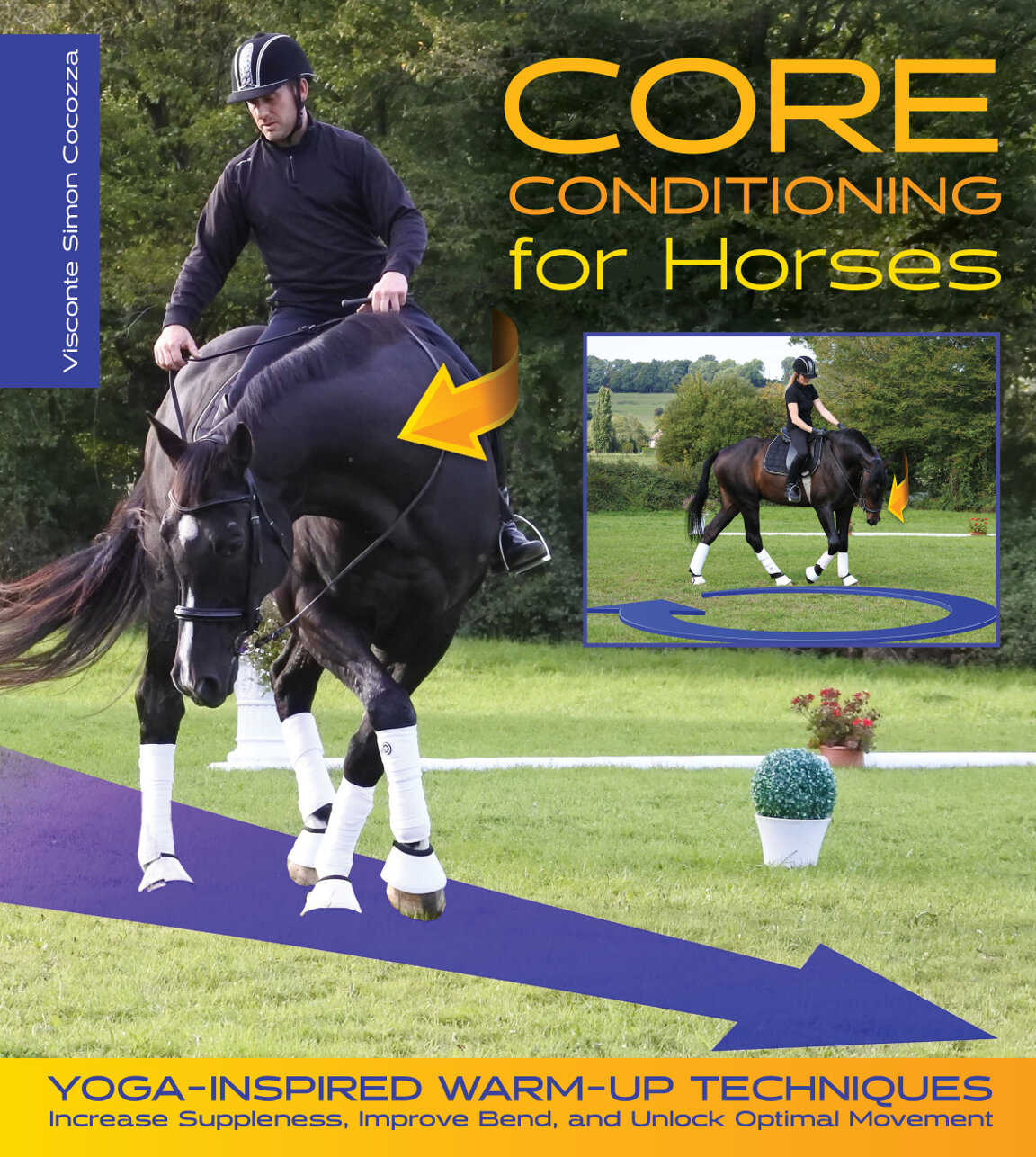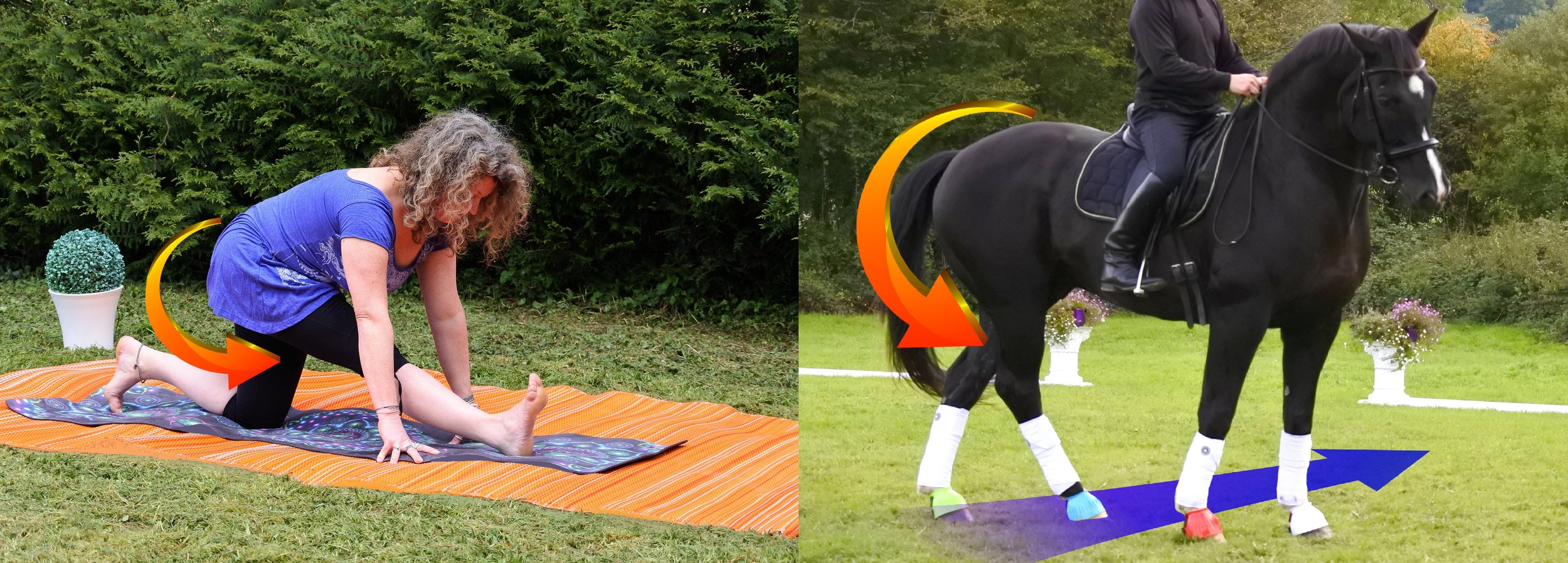The job of a trainer is to help a rider understand how to help their horse become physically and emotionally capable of easily performing the job, and thus happy to join in with the human's journey. Only then do horse and rider truly connect, both physically and psychologically, and then something wonderful happens: they begin to teach each other, intuitively, and without the need for anyone else. It is here that true beauty is found.
The trick, then, is to find a way of working with our equine companion that supples and conditions his/her body but without conflict and stress, but in a playful way where the end product is a strong, easy stride that can carry and respond to a human with ease. Then we have a happy horse. Below is a brief description of my preferred method of training the equine athlete.
Suppleness, mobility and freedom are the most important of all
'Releasing the Horse's Inner Dancer'
Some horses float, can read your mind and are inspirational to ride. For every one of those, there are unfortunately many very complicated ones. There is a reason. These less able horses are not being difficult, lazy or even limited. They are having trouble moving their bodies easily. Solve this, and all horses can move with grace.
It is often confusing that two similarly built horses, with comparable quality of bloodline and sporting conformation, can give two totally different rides. Often the horses in question will move promisingly when young moving freely in the field yet the process of being ridden seems to flatten this expression permanently in all but a few.
If we want to improve any horse's movement, this is our first clue.
Traditional training techniques are rooted in our ancient military, where function was prized over sentiment as few involved were expected to reach old age. These methods have us developing the horse's muscular massive driving muscles along with progressive education and cardiovascular conditioning to perform a task in the eventuality of war. This is perhaps at odds with our modern desire to have an above all happy companion in our riding pleasure.
Coercion can produce spectacular feats, yet the dominance of whip, spur and leveraged bits is deeply unethical and unnecessary with such sensitive creatures.
To make life even more confusing, the Masters of past and present have had the luxury of selecting only the best examples with which to work and study, leaving us very short of historically proven methods to help the rest and traditional solutions that may solve all by sending horses forward under impulsion does not improve restrictions or and skeletal mal-alignment. The result is our greatest enemy, tension.
Horses don't yelp!
Our horses have very different ways of describing their physical and psychological state than most mammals. For millions of years, not becoming le plat du jour to predators has taught the equine to be very discreet and not attract attention by looking weakened in any way. Obvious signs of limited mobility would be a very bad idea with wolves around so horses instinctively hide injury or physical restriction so as to disguise any sign that they might be easy to catch.
Unfortunately this instinct works against the ridden horse as he seems to be going along with things without complaint. This does not mean all is well. The horse does show where it hurts however, in the way he moves, by not using the affected area of the body properly. With four limbs, the horse can keep moving even with many locked areas making it hard for us to distinguish between a problem and 'thats' just how he goes'.
Some common examples of a horse's physical expression showing physical restriction are:
Stiff to one side, usually the left
Uncomfortable. bumpy gaits, particularly in sitting trot
flat paces, no expression
slow response to aids
falling into corners on one rein and falling out out on the other
unbalanced towards the forehand therefore difficult to stop/go
unwillingness, unhappy, indifferent, grumpy, bitey, kicky etc. Just as grumpy as we are when we hurt and have to move!
Much of the time we become focused on solving these symptoms rather than exploring the possibility of a common, the underlying cause and traditional solutions that send horses forward under impulsion does not improve restrictions or and skeletal misalignment. The result is tension.
What is happening inside our horses?
The natural reaction of the young horse to the introduction of rider weight is to stabilise this addition of weight by widening his stance and involuntarily allowing the added weight to hang down on his spine. This bio-mechanical system was simply not designed to carry a human in the middle of the spine and it dips slightly.
This shortens the longissimus muscles above his spine and lengthens the mutifidus muscles underneath it.
Being cooperative in nature along with lacking the muscles to support the spine and the rider, the soft backed horse will carry on trying to comply.
As training progresses his shoulder and rear muscles get stronger and he becomes more and more efficient at meeting our demands by displacing his limbs as best he can. Unfortunately the dipped back is easily established as the horse does not know to correct this him/herself, and this becomes the root of restriction and difficulty we meet later on.
Two problems are becoming established at this point.
The 'sagging' his back against our weight and lowering the thoracic section of his spine between his shoulder blades (thoracic sling
The saddle sits in the middle of the weakest part of the horse
If the spine remains dipped for long enough, the processes can come into contact as their vertebrae have become 'kinked' (spondylosis)
When this happens we lose the magical part of a horse's movement, The supple, elastic viceral connection between the front, the quarters and ourselves. We can't see this happening as the bones and muscles involved are deep within the body and the horse with ultimate kindness, carries on and works around this incorrect posture until we find what seems to be 'mystery' limitations to performance and excessive strain injuries appearing in the limbs.
If the spine remains dipped for long enough, the processes can come into contact as their vertebrae have become 'kinked' (spondylosis)
To limit discomfort the horse will tense the muscles we are sitting on (longissimus dorsii) to stop the processes from rubbing together. We see a number of defences, avoidances and injuries gradually setting in as the horse simply cannot do as we are asking.
The adult spine has 32 bones and has overall a very wide range of movement that gives the horse his athleticism. Without us the system is perfectly balanced and extremely well designed for moving the animal from grazing areas and fleeing predators, yet when we sit in the middle of their backs we change the dynamics of their body in many ways.
Not unlike our cars, this is an engineering issue as the horse's body is after all just a biological mechanism. If you have a flat tyre the car pulls to that side. A binding brake or a bad shock absorber will ruin the driving dynamics. Similarly with the horse, if he is not using himself evenly, turning is difficult as the weight and trajectories are not in balance as he is falling to the side as well as forward, be difficult to 'drive' and lose his beauty and grace. Even a Ferrari with flat tyres will drive terribly! When the horses spine is malfunctioning, all the subtle dynamics of limb flight and joint trajectories are thrown out of line causing all sorts of restrictions, imbalances and forces all over his body.
When this happens it is not a surprise that we don't feel completely in control...we arent! As a result we are being thrown around, incapable of being soft and light and it becomes all we can do just to go with all the movement. We must remember that the horse's body has been perfectly designed and if we can help realign the chassis, all the ideas of how to ride sensitively can be possible for all of us.
If the rider has been trying to ride well and follow what would be good advice if the horse were not 'locked', even correct training techniques will fail to produce good results. When the horse's centre is not moving and the horse is displacing himself with his limbs only, his back oscillates up and down in a movement almost impossible to relax to. This is where we are sitting so we are to a greater or lesser extent being jiggled around to downright ejected. We see this at even the highest levels of our sport, albeit well disguised! When we are uncomfortable subtle riding is impossible and all the horse can feel is our gross and inconsistent aids, gripping arms and legs which become unintelligible white noise that is impossible to understand as it has no consistency. This creates a vicious circle of tension by hollowing even further against our unstable weight, along with the horse 'shutting down' to our sea of movement and pressure. We would do the same.
When correct in the back horses are very comfortable. Only then can we relax, not hang on in any way and deliver super sensitive signals. We have to break the bad cycle first, to allow the good to be heard.
A dancer must train the whole body, as any weak area will limit performance
If we want our horses to dance, we have to train them like dancers. Human athletes spend the majority of their time preparing the body for intense physicality, rather than just 'dancing'. This would produce a limited performance as the athlete must have a wide and comfortable range of motion if they are to be fluid in action. We supple and strengthen the whole body before adding power, with particular attention to the torso, or core muscles.
Why do we things so differently with the horse?
We need to consider the benefits of using this tried and tested methodology to our equine friends in training. Currently trends are to have a walk, trot and canter on both reins in an open frame. This may warm the large muscle groups but it does not supple the back.
If we wish to condition the spinal muscles, slow and coordinated exercises are the key,taking any tension away as we fully mobilise the body with sympathy, as we would want ourselves. Using flexing exercises that increase lateral, longitudinal and rotational range of motion is the very best preparation for faster work, gradually activating and strengthening the complex muscles that tie the horses front to his rear, connecting the two into a strong and flexible co-ordination. This is how top horses feel, for a reason. So we then should train our horses to be round in the back, not in the neck and able to bear weight along a wide range of limb motion.
Increasing range of motion liberates the body to perform with grace
So, by taking the parallel of the human body and what we know works best, we can adapt the very same exercises to the quadruped, who suffers the same things, in the same ways and for the same reasons.












